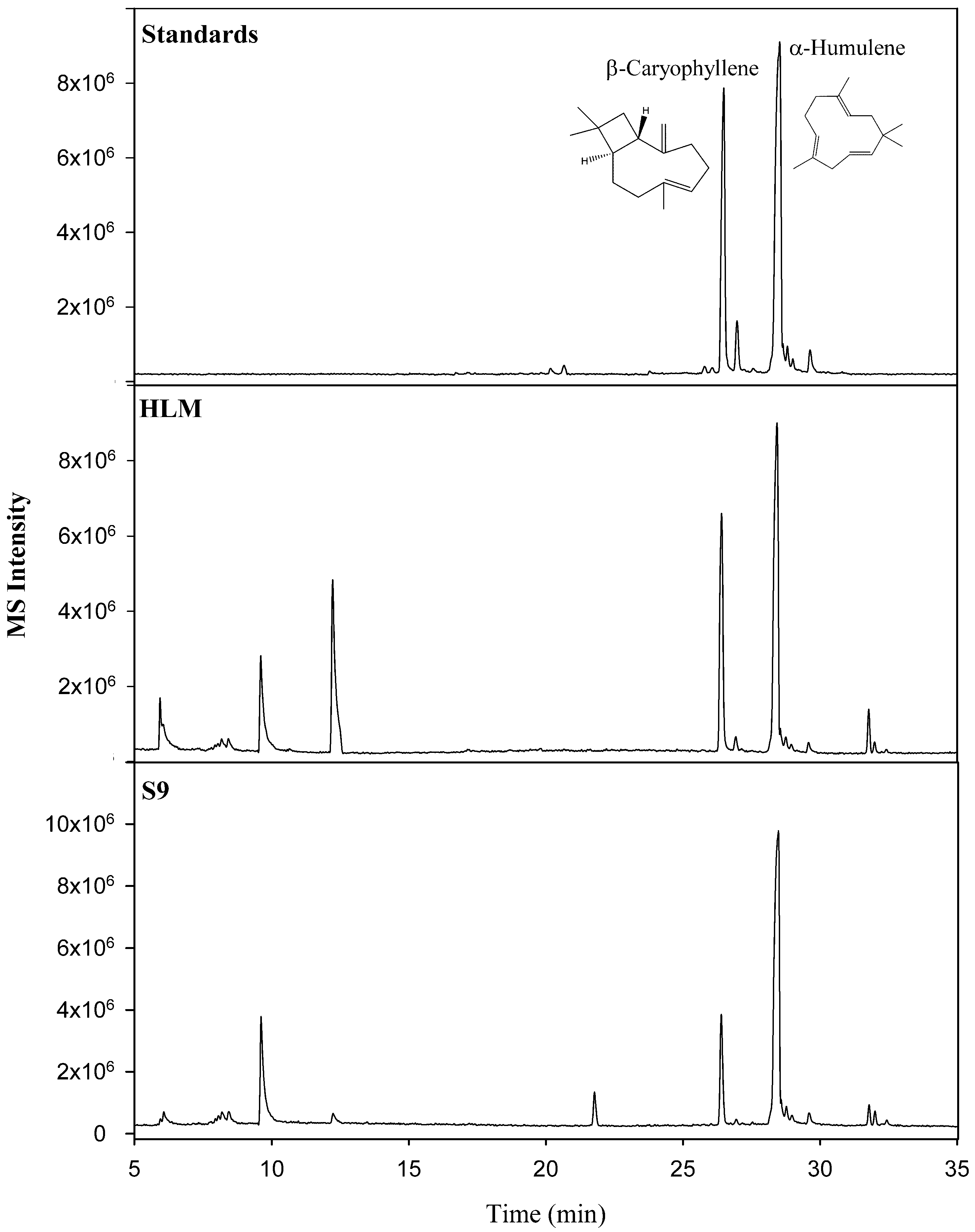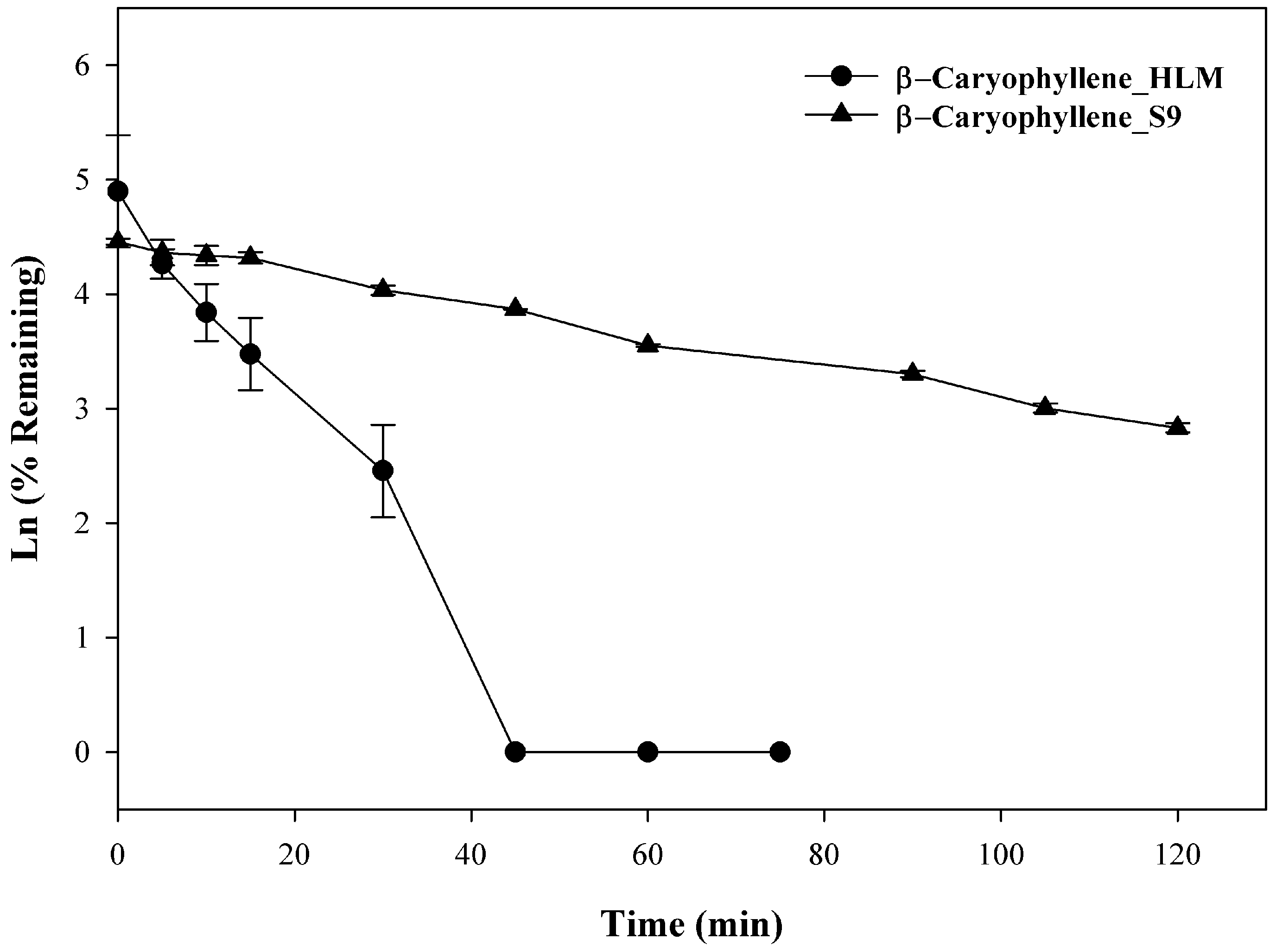Development of a GC/Q-ToF-MS Method Coupled with Headspace Solid-Phase Microextraction to Evaluate the In Vitro Metabolism of β-Caryophyllene
Abstract
1. Introduction
2. Results
2.1. HS-SPME GC/Q-ToF-MS Method Development and Optimization
2.2. HS-SPME GC/Q-ToF-MS Method Validation
2.2.1. Selectivity
2.2.2. Linearity and Sensitivity
2.2.3. Precision and Accuracy
2.3. In Vitro Metabolism
3. Materials and Methods
3.1. Materials
3.2. Sample Preparation
3.3. HS-SPME and GC/Q-TOF-MS Instrument Conditions
3.4. Quantitative Analysis
3.5. Method Validation
3.6. Metabolic Stability of β-Caryophyllene in Human Liver Microsomes and S9 Fractions
4. Conclusions
Author Contributions
Funding
Institutional Review Board Statement
Informed Consent Statement
Data Availability Statement
Conflicts of Interest
References
- Goryński, K.; Goryńska, P.; Górska, A.; Harężlak, T.; Jaroch, A.; Jaroch, K.; Lendor, S.; Skobowiat, C.; Bojko, B. SPME as a promising tool in translational medicine and drug discovery: From bench to bedside. J. Pharm. Biomed. Anal. 2016, 130, 55–67. [Google Scholar] [CrossRef] [PubMed]
- Belardi, R.P.; Pawliszyn, J.B. The application of chemically modified fused silica fibers in the extraction of organics from water matrix samples and their rapid transfer to capillary columns. Water Qual. Res. J. 1989, 24, 179–191. [Google Scholar] [CrossRef]
- Bojko, B.; Cudjoe, E.; Gómez-Ríos, G.A.; Gorynski, K.; Jiang, R.; Reyes-Garcés, N.; Risticevic, S.; Silva, É.A.; Togunde, O.; Vuckovic, D. SPME—Quo vadis? Anal. Chim. Acta 2012, 750, 132–151. [Google Scholar] [CrossRef] [PubMed]
- Jalili, V.; Barkhordari, A.; Ghiasvand, A. A comprehensive look at solid-phase microextraction technique: A review of reviews. Microchem. J. 2020, 152, 104319. [Google Scholar] [CrossRef]
- Kataoka, H.; Saito, K. Recent Advances in SPME Techniques in biomedical analysis. J. Pharm. Biomed. Anal. 2011, 54, 926–950. [Google Scholar] [CrossRef] [PubMed]
- Souza-Silva, É.A.; Gionfriddo, E.; Pawliszyn, J. A critical review of the state of the art of solid-phase microextraction of complex matrices II. Food analysis. TrAC Trends Anal. Chem. 2015, 71, 236–248. [Google Scholar] [CrossRef]
- Feng, X.; Wang, H.; Wang, Z.; Huang, P.; Kan, J. Discrimination and characterization of the volatile organic compounds in eight kinds of huajiao with geographical indication of China using electronic nose, HS-GC-IMS and HS-SPME-GC–MS. Food Chem. 2022, 375, 131671. [Google Scholar] [CrossRef]
- Qi, H.; Ding, S.; Pan, Z.; Li, X.; Fu, F. Characteristic volatile fingerprints and odor activity values in different citrus-tea by HS-GC-IMS and HS-SPME-GC-MS. Molecules 2020, 25, 6027. [Google Scholar] [CrossRef] [PubMed]
- Qian, C.; Quan, W.; Li, C.; Xiang, Z. Analysis of volatile terpenoid compounds in rhododendron species by multidimensional gas chromatography with quadrupole time-of-flight mass spectrometry. Microchem. J. 2019, 149, 104064. [Google Scholar] [CrossRef]
- Cardinali, F.L.; Ashley, D.L.; Wooten, J.V.; McCraw, J.M.; Lemire, S.W. The use of solid-phase microextraction in conjunction with a benchtop quadrupole mass spectrometer for the analysis of volatile organic compounds in human blood at the low parts-per-trillion level. J. Chromatogr. Sci. 2000, 38, 49–54. [Google Scholar] [CrossRef] [PubMed]
- Walker, R.; Flanagan, R.J.; Lennard, M.S.; Mills, G.A.; Walker, V. Solid-phase microextraction: Investigation of the metabolism of substances that may be abused by inhalation. J. Chromatogr. Sci. 2006, 44, 387–393. [Google Scholar] [CrossRef] [PubMed]
- Nichols, J.W.; Hoffman, A.D.; ter Laak, T.L.; Fitzsimmons, P.N. Hepatic clearance of 6 polycyclic aromatic hydrocarbons by isolated perfused trout livers: Prediction from in vitro clearance by liver S9 fractions. Toxicol. Sci. 2013, 136, 359–372. [Google Scholar] [CrossRef] [PubMed]
- Lima, S.R.; Junior, V.F.V.; Christo, H.B.; Pinto, A.C.; Fernandes, P.D. In vivo and in vitro studies on the anticancer activity of copaifera multijuga hayne and its fractions. Phytother. Res. Int. J. Devoted Pharmacol. Toxicol. Eval. Nat. Prod. Deriv. 2003, 17, 1048–1053. [Google Scholar] [CrossRef]
- Junior, V.V.; Rosas, E.; Carvalho, M.V.d.; Henriques, M.d.G.M.d.O.; Pinto, A.C. Chemical composition and anti-inflammatory activity of copaiba oils from Copaifera cearensis Huber ex Ducke, Copaifera reticulata Ducke and Copaifera multijuga Hayne—A comparative study. J. Ethnopharmacol. 2007, 112, 248–254. [Google Scholar] [CrossRef]
- Nguyen, L.T.; Myslivečková, Z.; Szotáková, B.; Špičáková, A.; Lněničková, K.; Ambrož, M.; Kubíček, V.; Krasulová, K.; Anzenbacher, P.; Skálová, L. The inhibitory effects of β-caryophyllene, β-caryophyllene oxide and α-humulene on the activities of the main drug-metabolizing enzymes in rat and human liver in vitro. Chem. Biol. Interact. 2017, 278, 123–128. [Google Scholar] [CrossRef] [PubMed]
- Singh, J. International Conference on Harmonization (ICH) of Technical Requirements for Registration of Pharmaceuticals for Human Use. J. Pharmacol. Pharmacother. 2015, 6, 185–187. [Google Scholar] [CrossRef] [PubMed]
- FDA. Guidance for Industry Bioanalytical Method Validation; FDA: White Oak, MD, USA, 2001.
- Asakawa, Y.; Taira, Z.; Takemoto, T.; Ishida, T.; Kido, M.; Ichikawa, Y. X-ray crystal structure analysis of 14-hydroxycaryophyllene oxide, a new metabolite of (—)-caryophyllene, in rabbits. J. Pharm. Sci. 1981, 70, 710–711. [Google Scholar] [CrossRef] [PubMed]
- Liu, H.; Yang, G.; Tang, Y.; Cao, D.; Qi, T.; Qi, Y.; Fan, G. Physicochemical characterization and pharmacokinetics evaluation of beta-caryophyllene/beta-cyclodextrin inclusion complex. Int. J. Pharm. 2013, 450, 304–310. [Google Scholar] [CrossRef] [PubMed]
- Manda, V.K.; Avula, B.; Ali, Z.; Khan, I.A.; Walker, L.A.; Khan, S.I. Evaluation of in vitro Absorption, Distribution, Metabolism, and Excretion (ADME) properties of mitragynine, 7-hydroxymitragynine, and mitraphylline. Planta Med. 2014, 80, 568–576. [Google Scholar] [CrossRef] [PubMed]



| Compound | Intra-Day | |||||||||
|---|---|---|---|---|---|---|---|---|---|---|
| Nominal Conc. (ng/mL) | Day-1 (n = 3) | Day-2 (n = 3) | Day-3 (n = 3) | |||||||
| Detected Conc. (ng/mL) | Precision (RSD%) | Accuracy (%) | Detected Conc. (ng/mL) | Precision (RSD%) | Accuracy (%) | Detected Conc. (ng/mL) | Precision (RSD%) | Accuracy (%) | ||
| β-caryophyllene | 50 | 50.09 | 1.23 | 100.17 | 52.38 | 3.44 | 104.76 | 50.83 | 2.64 | 101.67 |
| 75 | 81.98 | 2.81 | 109.66 | 82.24 | 4.43 | 109.66 | 80.34 | 5.20 | 107.12 | |
| 250 | 281.92 | 6.91 | 112.77 | 248.60 | 3.48 | 99.44 | 283.18 | 2.63 | 113.27 | |
| 500 | 490.78 | 4.90 | 98.16 | 530.53 | 3.18 | 106.11 | 534.53 | 2.90 | 106.91 | |
| Compound | Nominal Conc. (ng/mL) | Inter-Day (n = 9) | ||
|---|---|---|---|---|
| Detected Conc. (ng/mL) | Precision (RSD%) | Accuracy (%) | ||
| β-caryophyllene | 50 | 51.10 | 4.16 | 102.20 |
| 75 | 81.52 | 3.84 | 108.70 | |
| 250 | 271.23 | 7.52 | 108.49 | |
| 500 | 518.62 | 5.15 | 103.72 | |
Publisher’s Note: MDPI stays neutral with regard to jurisdictional claims in published maps and institutional affiliations. |
© 2022 by the authors. Licensee MDPI, Basel, Switzerland. This article is an open access article distributed under the terms and conditions of the Creative Commons Attribution (CC BY) license (https://creativecommons.org/licenses/by/4.0/).
Share and Cite
Lee, J.; Wang, M.; Mondal, G.; Khan, I.A.; Yates, C.R. Development of a GC/Q-ToF-MS Method Coupled with Headspace Solid-Phase Microextraction to Evaluate the In Vitro Metabolism of β-Caryophyllene. Molecules 2022, 27, 7441. https://doi.org/10.3390/molecules27217441
Lee J, Wang M, Mondal G, Khan IA, Yates CR. Development of a GC/Q-ToF-MS Method Coupled with Headspace Solid-Phase Microextraction to Evaluate the In Vitro Metabolism of β-Caryophyllene. Molecules. 2022; 27(21):7441. https://doi.org/10.3390/molecules27217441
Chicago/Turabian StyleLee, Joseph, Mei Wang, Goutam Mondal, Ikhlas A. Khan, and Charles R. Yates. 2022. "Development of a GC/Q-ToF-MS Method Coupled with Headspace Solid-Phase Microextraction to Evaluate the In Vitro Metabolism of β-Caryophyllene" Molecules 27, no. 21: 7441. https://doi.org/10.3390/molecules27217441
APA StyleLee, J., Wang, M., Mondal, G., Khan, I. A., & Yates, C. R. (2022). Development of a GC/Q-ToF-MS Method Coupled with Headspace Solid-Phase Microextraction to Evaluate the In Vitro Metabolism of β-Caryophyllene. Molecules, 27(21), 7441. https://doi.org/10.3390/molecules27217441







